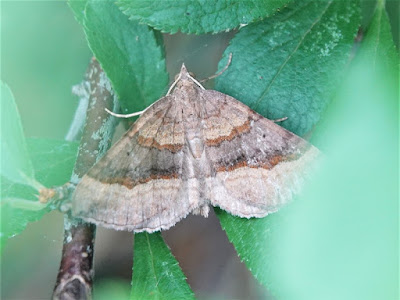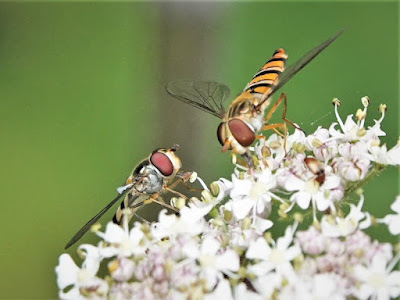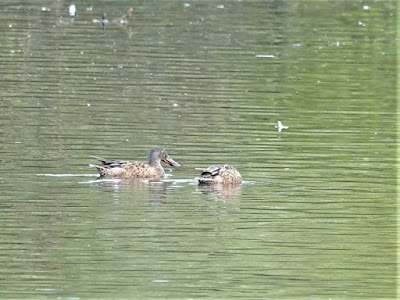14.0°C > 21.0°C: Broken cloud with only a few sunny intervals. Light westerly breeze. Very good visibility.
Sunrise: 04:58 BST
* = a species photographed today
$ = my first sighting of the species for this year
$$ = my first ever recorded sighting of the species in the area
Priorslee Balancing Lake: 05:00 – 06:20 // 07:40 – 10:00
(166th visit of the year)
Bird notes:
- the Greylag Geese parents and their three goslings have left. The supernumerary adult Greylag is still present along with eight Canada Geese which includes the now fully grown gosling.
- only the cob resident Mute Swan was noted. He made one visit to the nest area.
- five groups of Mallard ducklings seen: the duo; the familiar group of four; now only nine well-grown birds; a group of five and yet another new brood of eight. *The ducklings in this latter brood are wayward, scattering away from Mum on occasions.
- I think we can say the the duck Pochard has definitely gone. I hope she grew new wings and flew away.
- *there are three juvenile Great Crested Grebes in what I though were the newest brood. I was confused by finding a single juvenile in a fourth brood, this about the same size as the three.
- there were seven Black-headed Gulls on the football field at 06:10. I am presuming the few on the grass and buoys at the lake later were the same birds.
- a Common Kestrel flew south-west across the water at 08:45.
- I did not hear the Cetti's Warbler this morning. However while using the Merlin app to decide whether I was hearing Coal Tit or Tree Creeper (the answer was both!) the app recorded Cetti's Warbler. So...?
- a Garden Warbler only heard calling.
- a Common Whitethroats also only heard calling.
- a very small movement of Jackdaws and Rooks with almost as many after 08:00 as the usual 05:30 timing.
Bird(s) noted flying over here:
- 4 Greylag Geese
- 92 Wood Pigeons
- 3 Lesser Black-backed Gulls
- 1 Common Kestrel
- 18 Jackdaws
- 15 Rooks
Counts from the lake area:
- 7 + 1 (1 brood) Canada Geese
- 1 Greylag Goose
- 1 Mute Swan
- *25 (?♂) + 28 (5 broods) Mallard: see notes
- 7 Moorhens
- 98 adult and juvenile Coots: more late new broods
- *8 + 6 (4 broods) Great Crested Grebes: see notes
- 7 Black-headed Gulls: see notes
- 2 Herring Gulls
- 3 Lesser Black-backed Gulls
- 1 Grey Heron
Hirundines etc. noted:
- 5 Swifts
- 2 House Martins
Warblers recorded (the figure in brackets is birds noted singing):
song now much diminished
- ? Cetti's Warbler: see notes
- 7 (6) Chiffchaffs
- *10 (5) Reed Warblers
- 6 (4) Blackcaps
- 1 (0) Garden Warbler
- 1 (0) Common Whitethroat
On the West end street lamp poles around-dawn:
Nothing was noted
Moths:
*1 Common Plume Emmelina monodactyla
*1 Common Plume Emmelina monodactyla
Spiders, harvestmen etc.:
1 Bridge Orb-web Spider Larinioides sclopetarius
1 harvestman Dicranopalpus ramosus/caudatus
1 harvestman Leiobunum blackwalli / rotundum
Noted later:
1 Bridge Orb-web Spider Larinioides sclopetarius
1 harvestman Dicranopalpus ramosus/caudatus
1 harvestman Leiobunum blackwalli / rotundum
Noted later:
Butterflies:
Large White Pieris brassicae
"unidentified whites"
Speckled Wood Pararge aegeria
Ringlet Aphantopus hyperantus
*Meadow Brown Maniola jurtina
*Gatekeeper Pyronia tithonus
Large White Pieris brassicae
"unidentified whites"
Speckled Wood Pararge aegeria
Ringlet Aphantopus hyperantus
*Meadow Brown Maniola jurtina
*Gatekeeper Pyronia tithonus
Moths [62 species here before today; one addition today]
$ >12 Horse-chestnut Leaf-miner Cameraria ohridella
2 Pale Straw Pearls Udea lutealis
*3 Shaded Broad-bars Scotopteryx chenopodiata
*1 caterpillar of Vapourer Orgyia antiqua
1 caterpillar of Cinnabar Tyria jacobaeae
$ >12 Horse-chestnut Leaf-miner Cameraria ohridella
2 Pale Straw Pearls Udea lutealis
*3 Shaded Broad-bars Scotopteryx chenopodiata
*1 caterpillar of Vapourer Orgyia antiqua
1 caterpillar of Cinnabar Tyria jacobaeae
Bees, wasps etc.:
Honey Bee Apis mellifera
Red-tailed Bumblebee Bombus lapidarius
Common Carder Bee Bombus pascuorum
Common Wasp Paravespula vulgaris
Honey Bee Apis mellifera
Red-tailed Bumblebee Bombus lapidarius
Common Carder Bee Bombus pascuorum
Common Wasp Paravespula vulgaris
Hoverflies:
Bumblebee Blacklet Cheilosia illustrata [Bumblebee Blacklet]
*Parsley Blacklet Cheilosia pagana
*Stripe-backed Fleckwing Dasysyrphus albostriatus [Stripe-backed Brusheye]
* $ Broad-banded Epistrophe Epistrophe grossulariae [Black-horned Smoothtail]
*Marmalade Hoverfly Episyrphus balteatus
Tapered Dronefly Eristalis pertinax
Migrant Field Syrph Eupeodes corollae [Migrant Hoverfly; Migrant Aphideater]
Meadow Field Syrph Eupeodes latifasciatus [Broad-banded Aphideater]
*Common Spotted Field Syrph Eupeodes luniger [Lunuled Aphideater]
*Chequered Hoverfly Melanostoma scalare [Long-winged Duskyface]
*Banded Meliscaeva Meliscaeva cinctella [Banded Thintail]
Syrphus sp. S. ribesii / S. vitripennis
Bumblebee Blacklet Cheilosia illustrata [Bumblebee Blacklet]
*Parsley Blacklet Cheilosia pagana
*Stripe-backed Fleckwing Dasysyrphus albostriatus [Stripe-backed Brusheye]
* $ Broad-banded Epistrophe Epistrophe grossulariae [Black-horned Smoothtail]
*Marmalade Hoverfly Episyrphus balteatus
Tapered Dronefly Eristalis pertinax
Migrant Field Syrph Eupeodes corollae [Migrant Hoverfly; Migrant Aphideater]
Meadow Field Syrph Eupeodes latifasciatus [Broad-banded Aphideater]
*Common Spotted Field Syrph Eupeodes luniger [Lunuled Aphideater]
*Chequered Hoverfly Melanostoma scalare [Long-winged Duskyface]
*Banded Meliscaeva Meliscaeva cinctella [Banded Thintail]
Syrphus sp. S. ribesii / S. vitripennis
Dragon-/Damsel-flies:
Common Blue Damselfly Enallagma cyathigerum [Common Bluet]
where have all the Azure Damselfly gone?
unidentified hawker sp.
Common Blue Damselfly Enallagma cyathigerum [Common Bluet]
where have all the Azure Damselfly gone?
unidentified hawker sp.
Lacewings, caddis flies etc.:
unidentified leafhopper
unidentified leafhopper
Other flies:
none specifically identified
plus
as usual many unidentified flies of many different species
none specifically identified
plus
as usual many unidentified flies of many different species
Bugs:
none
none
Beetles:
7 Spot Ladybird Coccinella 7-punctata
Common Red Soldier Beetle Rhagonycha fulva
7 Spot Ladybird Coccinella 7-punctata
Common Red Soldier Beetle Rhagonycha fulva
Slugs, snails etc.:
White-lipped Snail Cepaea hortensis
White-lipped Snail Cepaea hortensis
Amphibians:
none
none
Spiders, harvestmen etc.:
money spider Erigone sp.
*Zebra Spider Salticus scenicus
money spider Erigone sp.
*Zebra Spider Salticus scenicus
New plants for the year:
None
The latest brood of eight small Mallard. These are tending to scatter all over and I am not sure Mum will be able to protect them.
A parent Great Crested Grebe with the three juveniles. Note that even at this age the juveniles have huge feet – the bird on the left is waving one about. All the better to paddle and dive with.
This gives a good idea of the size of a Chequered Hoverfly Melanostoma scalare, here sitting on just one flower of one umbel of a Common Hogweed Heracleum sphondylium.
(Ed Wilson)
In the Priorslee Avenue tunnel:
(164th visit of the year)
Bird notes:
- a few geese of both species were seen making tentative flights on new wings. Many are obviously some way away from the feathers having regrown sufficiently.
- *unexpected at this date were two Shoveler. Both out of plumage and at some distance but I would judge a drake and a duck.
- the late brood of two Mallard ducklings not noted.
- 11 Tufted Duck only.
- again only two Great Crested Grebes found. Both in open areas of water a ways away from each other and staying that way.
Bird(s) noted flying over here:
- 2 Jackdaws
Noted on / around the water:
- 153 Canada Geese
- 74 Greylag Geese
- the mainly white feral goose not noted
- 6 Mute Swans
- *2 (1♂?) Shoveler
- 9 (?♂) Mallard: see notes
- 11 (8♂) Tufted Duck
- 5 + 1 (1 brood) Moorhens
- 67 + 8 (4 broods) Coots: two new broods noted
- 2 Great Crested Grebes again: see notes
Hirundines etc. noted:
- 2 Swifts
Warblers recorded (the figure in brackets is birds noted singing):
- 4 (3) Chiffchaffs
- 4 (3) Blackcaps
Noted around the area:
The latest brood of eight small Mallard. These are tending to scatter all over and I am not sure Mum will be able to protect them.
A parent arrives with food...
...which soon wakes the juveniles up.
A fledged juvenile Reed Warbler peeking out at me.
And apparently not pleased with what it sees.
An acrobatic juvenile Blue Tit gathering insects from the umbellifers.
It is the yellow tone to its belly that suggests it is a juvenile.
A perfectly posed male Gatekeeper Pyronia tithonus – the dark in the forewing indicates it is a male. Two white spots in the black circle for this species....
...but only one for the larger Meadow Brown Maniola jurtina.
Leaves of Horse-chestnut Aesculus hippocastanum showing the damage inflicted by the larvae of the Horse-chestnut Leaf-miner moth Cameraria ohridella. At least a dozen tiny (5mm long) moths were flying around but would they land? Nope. All I managed was...
...this equally tiny and unidentified leafhopper.
At last: a moth on the street lamp poles here. A Common Plume Emmelina monodactyla. This species has multiple broods per year and I saw my first on 25 March.
A Shaded Broad-bar moth Scotopteryx chenopodiata.
This is bizarre for two reasons. Firstly the evolutionary result of this caterpillar of Vapourer Orgyia antiqua is unusual to say the least. Secondly this is the fourth example I have recorded this year, all on the surround of the "boxing ring" on the dam. The first was on 20 May so there is zero chance of them all being the same individual.
A perfect plan view.
A Parsley Blacklet hoverfly Cheilosia pagana.
A paler yellow on this hoverfly, with the yellow bands separated in the middle and two slightly divergent streaks on the thorax this is a Stripe-backed Fleckwing Dasysyrphus albostriatus.
Another "different-looking" hoverfly from all the many black and yellow species. The wide, parallel-sided yellow bands and the two streaks down the thorax identify a Broad-banded Epistrophe Epistrophe grossulariae which for some reason Obsidentify calls Black-horned Smoothtail. The antennae are not sufficiently visible here to know whether it has black horns.
Not really a stand-off as many species of hoverfly were sharing the umbellifers. On the left a Banded Meliscaeva Meliscaeva cinctella and on the right a Marmalade Hoverfly Episyrphus balteatus.
The moustache-like yellow marks suggest this is a Common Spotted Field Syrph Eupeodes luniger.
Two species of bug on a Common Knapweed Centaurea nigra flower. I cannot identify either!
On the wall of the sailing club HQ I found two Zebra Spiders Salticus scenicus. Here is one..
...and the other. When I was in Kenya the Zebras seemed differently marked!
(Ed Wilson)
------------------------------------------------------------------------------------------------------
In the Priorslee Avenue tunnel:
Moths: [26 species here before today; no additions]
none
none
Flies:
8 moth flies Psychodidae sp. [Drain Fly or Owl Fly]
8 midges of various species.
8 moth flies Psychodidae sp. [Drain Fly or Owl Fly]
8 midges of various species.
Spiders, harvestmen etc.:
none
(Ed Wilson)
The Flash: 06:25 – 07:35
none
(Ed Wilson)
------------------------------------------------------------------------------------------------------
The Flash: 06:25 – 07:35
(164th visit of the year)
Bird notes:
- a few geese of both species were seen making tentative flights on new wings. Many are obviously some way away from the feathers having regrown sufficiently.
- *unexpected at this date were two Shoveler. Both out of plumage and at some distance but I would judge a drake and a duck.
- the late brood of two Mallard ducklings not noted.
- 11 Tufted Duck only.
- again only two Great Crested Grebes found. Both in open areas of water a ways away from each other and staying that way.
Bird(s) noted flying over here:
- 2 Jackdaws
Noted on / around the water:
- 153 Canada Geese
- 74 Greylag Geese
- the mainly white feral goose not noted
- 6 Mute Swans
- *2 (1♂?) Shoveler
- 9 (?♂) Mallard: see notes
- 11 (8♂) Tufted Duck
- 5 + 1 (1 brood) Moorhens
- 67 + 8 (4 broods) Coots: two new broods noted
- 2 Great Crested Grebes again: see notes
Hirundines etc. noted:
- 2 Swifts
Warblers recorded (the figure in brackets is birds noted singing):
- 4 (3) Chiffchaffs
- 4 (3) Blackcaps
Noted around the area:
Butterflies:
none
none
Moths [on street lamp poles and in the grass] [50 species here before today; one addition today]
*1 $ Hoary Tortrix Eucosma cana [was Hoary Bell] [moth species #51]
1 Common Grass-moth Agriphila tristella [was Common Grass-veneer]
*1 $ Hoary Tortrix Eucosma cana [was Hoary Bell] [moth species #51]
1 Common Grass-moth Agriphila tristella [was Common Grass-veneer]
Bees, wasps etc.:
*$$ possible Saxon Wasp Dolichovespula saxonica
Common Wasp Paravespula vulgaris
*$$ possible Saxon Wasp Dolichovespula saxonica
Common Wasp Paravespula vulgaris
Hoverflies:
Marmalade Hoverfly Episyrphus balteatus
Meadow Field Syrph Eupeodes latifasciatus [Broad-banded Aphideater]
Common Spotted Field Syrph Eupeodes luniger [Lunuled Aphideater]
Chequered Hoverfly Melanostoma scalare [Long-winged Duskyface]
Marmalade Hoverfly Episyrphus balteatus
Meadow Field Syrph Eupeodes latifasciatus [Broad-banded Aphideater]
Common Spotted Field Syrph Eupeodes luniger [Lunuled Aphideater]
Chequered Hoverfly Melanostoma scalare [Long-winged Duskyface]
Dragon-/Damsel-flies:
none
none
Other flies:
numerous different midges and flies
numerous different midges and flies
Bugs:
Common Flower Bug Anthocoris nemorum
*Mirid bug Plagiognathus arbustorum
Common Flower Bug Anthocoris nemorum
*Mirid bug Plagiognathus arbustorum
Beetles:
larvae of Alder Leaf Beetle Agelastica alni
7 Spot Ladybird Coccinella 7-punctata
Common Red Soldier Beetle Rhagonycha fulva
larvae of Alder Leaf Beetle Agelastica alni
7 Spot Ladybird Coccinella 7-punctata
Common Red Soldier Beetle Rhagonycha fulva
Spiders, harvestmen etc.:
Long-jawed Orb-web Spider Tetragnatha sp.
harvestman Dicranopalpus ramosus/caudatus
female harvestman Leiobunum blackwalli
Long-jawed Orb-web Spider Tetragnatha sp.
harvestman Dicranopalpus ramosus/caudatus
female harvestman Leiobunum blackwalli
New flowers for the year:
None
Here are the two Shoveler I noted here. The right hand bird is, typically, sifting food with its bill from just below the surface.
This wasp struck me at the time as being unusually dark-looking. Obsidentify's first choice was Saxon Wasp Dolichovespula saxonica with Common Wasp Paravespula vulgaris being 25%. I am not sure but to my eyes the antennae look too long for a the Common Wasp though I cannot find that as a feature of Saxon Wasp in the literature.
A cooperative moth sitting on Common Ragwort Jacobaea vulgaris and allowing me to bend the plant over to get the best angle for an identification photo. It is a Hoary Tortrix Eucosma cana which used to be known as Hoary Bell. My 51st moth species here this year.
(Ed Wilson)
2012
Priorslee Lake
Grasshopper Warbler reeling
(Ed Wilson)
Here are the two Shoveler I noted here. The right hand bird is, typically, sifting food with its bill from just below the surface.
On my knuckle is a small Mirid bug Plagiognathus arbustorum.
(Ed Wilson)
------------------------------------------------------------------------------------------------------
2012
Priorslee Lake
Grasshopper Warbler reeling
(Ed Wilson)




























